Fiber Revolution: Spring 2022 SDJ, Out Now!
May 2, 2022
Surface Design Association is excited to announce Fiber Revolution, our Spring 2022 edition of Surface Design Journal. “This issue’s theme, Fiber Revolution (after all, what is a revolution but a circle?), highlights the work of artists and educators in our community who draw inspiration from the natural environment and adopt sustainable practices as part of their artistic output.” – Elizabeth Kozlowski
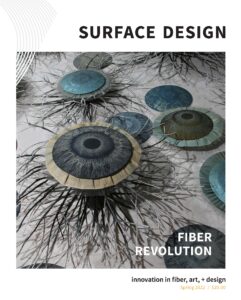
Here’s a preview of what you’ll discover:
“A Beautiful Shame: The Anti-Monuments Of Susie Ganch” by matt lambert: “As a fourth-generation jeweler, Susie Ganch cultivates a deep appreciation for how traditional materials are embedded with both “intrinsic and acquired” values and meanings. Ganch’s jewelry is deliberately ephemeral. The materials collected and used will become brittle, break down and eventually decay, rendering them unusable for future generations. Other pieces will participate in a circular economy, the parts disassembled and reused.”
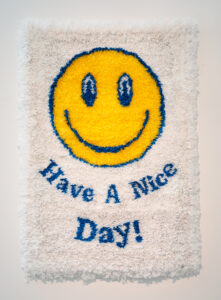
Susie Ganch, Have a Nice Day (from Please Recycle This Bag series), 2019. Collected single-use plastic shopping bags, 35 x 2.5 x 54 inches. Photo: David Hunter Hale.
“Resilience In Circular Culture” by Ginger Knowlton: “For a long while, we have lived in a linear economy in which natural resources are destined to turn to waste. Many artists, notably Maria Constanza Villarreal, work quietly and mindfully in ways that gently shift our attention and our gaze to a more hopeful circular economy and culture, guided by closed-loop economic systems devoted to zero waste, no pollution and a more finely tuned sense of community.”
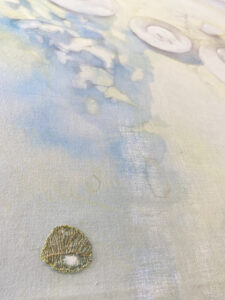
Maria Constanza Villarreal, Pulse of Morning II, 2020. Ink and silverpoint, embroidery on reclaimed linen, 47 x 55 inches, 2020. Photo by the artist.
“The Convergence Of Handicraft And Technological Innovation: New Trends In Fiber Art” by Yue Song: “Unlike natural evolution, the provocation of technological evolution occurs suddenly, and its changing effect on society and the world is often unpredictable. This is especially true of the technological revolution in the information age. The impact brought about by the combination of art and science has been felt for decades. This phenomenon deserves further examination: What future impacts will technological innovation have on traditional hand-woven culture? What kind of development opportunities will be brought to fiber art?”
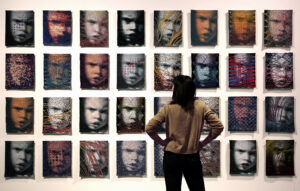
Lia Cook, Su Series (installation), 2016. Cotton, rayon, digitally woven, 32 pieces, 16 x 14 inches. Photo by the artist.
“Grown Beneath Our Feet” by Jessica Hemmings: “Mycelium’s speed of growth and relative ease of cultivation are often cited as positive environmental benefits of its production. Launched in 2015, Mycotech Lab, or MYCL, is an Indonesian bio-based material startup. Their location in an archipelago of 17,000 islands situated on the equator provides a hot and humid tropical climate, though temperatures are tempered a little by altitude in the city of Bandung in West Java, where the company is based. In short, it is a climate where things grow—and grow rapidly.”
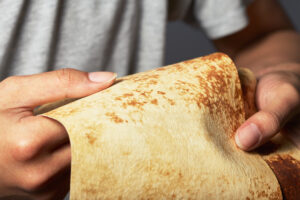
MYLEA Original Color, a sustainable and eco-friendly leather-like material made from agricultural waste and mushroom mycelium, 2020. MYCL, Bandung City, West Java, Indonesia.
“Kintra Fibers: Synthetic Textiles For A More Sustainable Future” by Rebecca Mcnamara: “Plastics are widespread throughout clothing and yarn, with polyester—usually petroleum-derived and made from polyethylene terephthalate (PET)—accounting for more than half of total global fiber production. While polyester,nylon, acrylic and other synthetic fibers may offer luxurious stretchiness, moisture-wicking properties, and a soft touch, they require the extraction of nonrenewable fossil fuels that harm the environment and result in landfill waste. Perhaps even more frightening, these fabrics release microparticles into our air and water systems with each use and wash.”
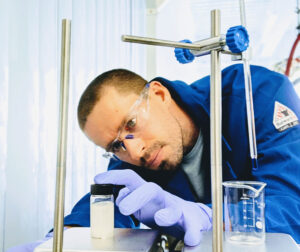
Billy McCall, Kintra co-founder and CEO works with the company’s bio-based resin in their Brooklyn Navy Yard lab. Image courtesy Kintra Fibers.
In The Studio: “Fences Make Poor Neighbors” by Joan Truckenbrod: “The structural parallel of chain-link (steel wire which forms a diamond-shaped mesh when woven) to weaving inspired my response: an action which disrupts the intent of the fencing by creating weavings with my hand-operated digital Jacquard TC2 loom. Separation implies difference among people. However, difference is socially constructed through markers such as race, gender, class and sexuality. I created this body of work to undermine both the separating power of the fence and social hierarchies.”
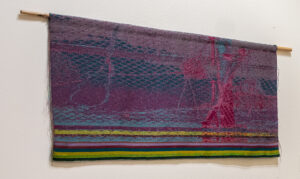
Joan Truckenbrod, Provocative Futures, 2021. Hand and digital Jacquard weaving, metallic, linen, bamboo, 28 x 56 inches. Photo: Schneider Art Museum.
First Person: “Heavenly Knitchet” by Heavenly Bresser: “My first experience on a spinning wheel was smooth. I picked up some Corriedale wool roving and just started spinning. It was as if I had spun my whole life. My feet knew what to do and so did my hands. It was then I knew handspinning was for me. My passion for handspinning grew and so did my herd of spinning wheels. Over the years, I have continued to save wheels from being burned or destined for the dump. Some of the wheels I own date back to the 1800s, and they continue to spin beautiful yarns.”

Heavenly Bresser sitting in front of a Finnish spinning wheel while spinning a batt of blended wool into singles, 2022. Photo by the artist.
In Conversation: “A Conscious Return To Zero: Conversations With Mary Curtis And Shelley Norton” by Grace Lai: “Over the years many companies and manufacturers have been called out in headline after headline for negligent and unethical processes that harm the environment. More often than not, instead of making impactful changes to combat climate change many hide behind fictitious claims or misleading jargon and a veil of greenwashing. Yet under the dark cloud of irresponsible and unsustainable production, there are those who are conscious of the impact their creations have on the planet. I speak to jewellers Mary Curtis and Shelley Norton about their practice and look at how waste has informed their works.”
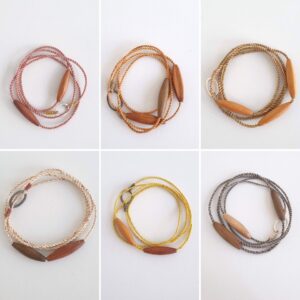
Mary Curtis, Selection of 2 Beads and 3 Beads, 2021. Hebe and oxalis flowers, lichen, spinach, eucalyptus bark, raw muka from rusted leaves, dyed, 16.5–23.5 x 1.5 inches wrapped. Image courtesy of the artist.
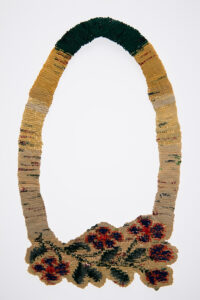
Shelley Norton, Necklace, 2014. Plastic, 14 x 8.25 inches. Image courtesy of Auckland Museum Tāmaki Paenga Hira.
Made Aware: “Any Texture” by Zwia Lipkin: “My interest in upcycling started decades ago in an arts high school. There, I worked with found objects to create collages and assemblages and wrote a thesis on the use of trash in modern art. I’ve always found beauty in the worn and weathered, in things with layers and a past. I later became a historian but maintained my interest in the overlooked.”
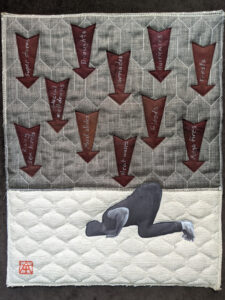
Zwia Lipkin, Wake Up Humanity!, 2021. Upcycled home décor fabrics, repurposed clothing painted with acrylic and printed fabric, raw edge fused appliqué, machine stitched, 16 x 20 inches.
Informed Source: “Manufactured River: Art And Wastewater Treatment” by Lindsay Olson: “Water is an intimate substance. We drink it, bathe in it, cook with it and use it sacramentally. We require it to live and are surrounded by it on our watery planet. Included in the hydrological cycle, but often overlooked, is the necessity of treated wastewater. I accidentally stumbled across not only a powerful source of inspiration, but also my artistic calling while canoeing down the Cal-Sag Channel in Chicago. A beautifully engineered waterfall in an obscure location led me to the world’s largest wastewater treatment plant in Stickney, Illinois.”
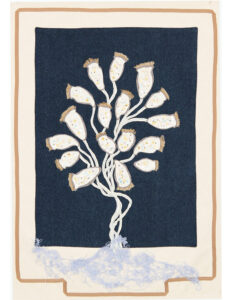
Lindsay Olson, Stalked Ciliate Carchesium, 2014. Collage, embroidery, deconstructed denim on canvas, 40 x 29 inches. Photo by the artist.
Spotlight On Education: “Umeed (Hope)” by Sadia Kausar: “Recycling has been a constant in the art of making textiles in Pakistan. Many markets in our city of Karachi sell waste materials from local textile industries. But due to lockdowns, it was entirely impossible for anyone to access such areas. Alongside ongoing virtual communication and counselling, I thought it would be constructive to engage students in activities that would help them grow and become more stable, psychologically and creatively.”
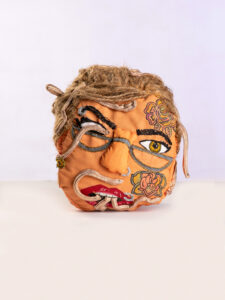
Laiba Masood, Medusa, 2021. Calico cotton, jute, metallic spandex, metallic viscose thread, metal wire, cotton thread, cotton fabric, fabric paint, dyes, embroidered, appliquéd, braided, painted, 5 x 8 inches.
To buy a copy of Fiber Revolution, go to the SDA Marketplace, or you can check out a free digital sample on our SDA Journal page.


